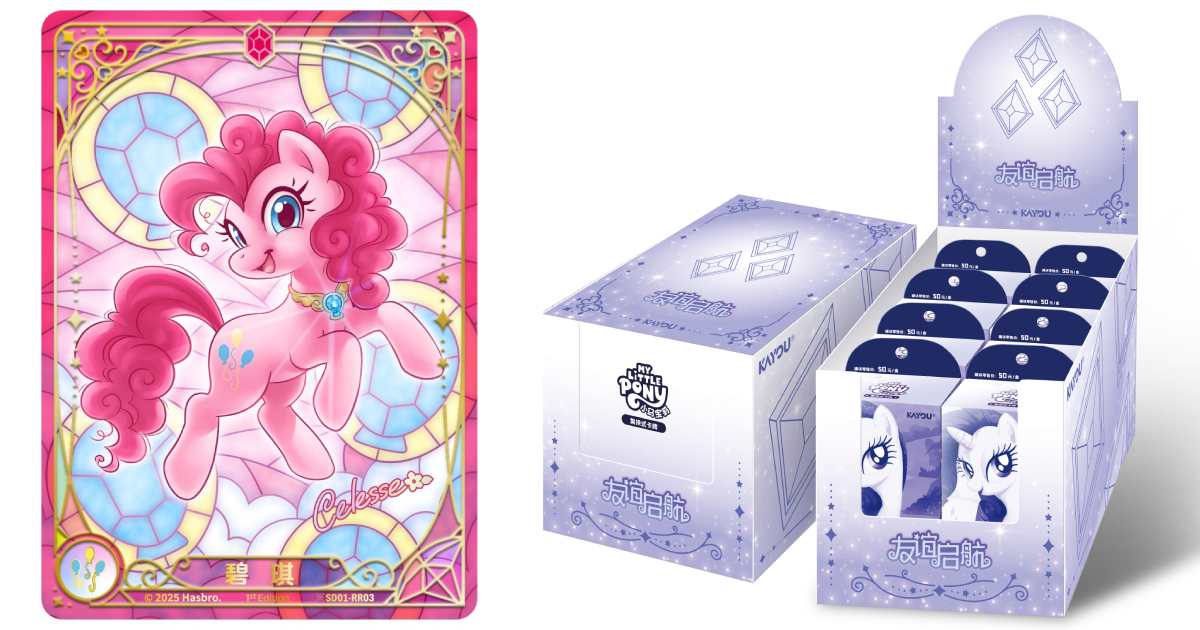Why Entertainment IPs Are the Perfect Fit for Trading Cards

An Executive Voices Blog by Marianne James, SVP of Global Licensing at Hasbro
Few formats offer the same mix of storytelling, nostalgia, and collectability as trading cards. And while many consumers associate trading cards most closely with sports brands, there is no denying that entertainment IPs are a perfect fit for the category.
To thrive in such a specialized space, however, expertise is required.
Hasbro began working with Shanghai-headquartered Kayou in 2021 to bring the My Little Pony and Transformers brands to the thriving world of trading cards and stationery. Hasbro contributed rich, multi-generational IP, while Kayou brought exceptional local expertise and distribution strength. That expertise is crucial, because the trading card category is complex.
For example, Hasbro and Kayou expanded their My Little Pony offerings with the franchise’s first-ever global trading card game, which features original card illustrations created by official Hasbro artists as well as renowned illustrators from around the world. Kayou is also building a global tournament system to provide a stage for players everywhere to connect, compete, and share on a global scale.
And while there is significant diversity within the trading card landscape, every card requires original artwork, rich storytelling, and dynamic gameplay mechanics.
Finding a partner with distribution strength is also essential as the trading card category continues to grow in popularity around the world. Asia is leading the way when it comes to trading card engagement, particularly in China. According to iResearch, China’s IP card market reached RMB 8.67 billion (USD 1.2 billion) in 2022, which shows an annual growth rate of nearly 35%.
Japan and North America are also highly engaged regions. Japan has a deep-rooted love for anime, manga, and character-based gaming, while the U.S. and Canada remain dominant players due to their strong collectibles culture and presence of major trading card manufacturers. In both markets, we’re seeing a growing appetite for IP-driven offerings beyond sports.
Trading cards are a multi-sensory experience, and fans love the thrill of the hunt—seeking out rare cards, building curated collections, and sharing those finds with their communities. Each collection becomes a personal expression of fandom, often sparking deeper engagement across social channels, livestreams, and even physical events. Nostalgia plays a huge role too. For many fans, trading cards offer a meaningful way to revisit their favorite characters and stories—rekindling childhood memories while creating new ones.
Globally, the trading card category is most popular among teens and young adults—especially Millennials—who are drawn in by that nostalgia, as well as collectability and the community aspect of card collecting.
In fact, a recent report from Market Decipher shows the global trading cards market is projected to reach $21 billion by 2034, with a robust CAGR of 8.5% over the next decade. Given that incredible response, we’re expanding into Southeast Asia and other territories later this year—turning this into a truly global play.
And within that projected growth, IP-driven trading cards are one of the fastest-growing segments. Brands are recognizing the unique value that trading cards offer as a storytelling vehicle and a gateway into fandom.
Entertainment brands—especially those with rich histories and a focus on storytelling—are perfectly positioned for the trading card category. These franchises are constantly evolving across entertainment, toys, fashion, digital platforms, and more. Trading cards add a new layer to that ecosystem—delivering emotional resonance, artistic expression, and the thrill of discovery in a highly social, collectible format. Trading cards celebrate both the heritage and the future of brands, and they align perfectly with a broader collectibles strategy.
Because of this, premium collectibles are another space we’re watching closely. One-off collectible pieces, figurines, and partworks offer a way to turn fan connection into something tangible and lasting—whether that’s a shelf-worthy display item or a meaningful keepsake.
Within the trading card landscape, specifically, we expect to see innovation across digital integrations, sustainable materials, and cross-category brand partnerships that elevate the collectible storytelling experience. There’s still so much untapped creative white space. The future of trading cards is bright—and full of potential.
Hasbro is a leading games, IP, and toy company whose mission is to create joy and community through the magic of play. With over 164 years of expertise, Hasbro delivers groundbreaking play experiences and reaches over 500 million kids, families, and fans around the world through physical and digital games, video games, toys, licensed consumer products, location-based entertainment, film, TV, and more




